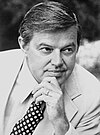1980 United States Senate election in Idaho
| |||||||||||||||||
| |||||||||||||||||
 County results Symms: 40–50% 50–60% 60–70% 70–80% Church: 40–50% 50–60% 60–70% | |||||||||||||||||
| |||||||||||||||||
| Elections in Idaho |
|---|
 |
The 1980 United States Senate election in Idaho took place on November 4, 1980 alongside other elections to the United States Senate in other states as well as elections to the United States House of Representatives and various state and local elections. Incumbent Democratic U.S. Senator Frank Church ran for re-election to a fifth term, but was narrowly defeated by Republican Steve Symms. Steve Symms's swearing-in marked the first time since 1957 that Republicans held both United States Senate seats from Idaho.
General election[edit]
Candidates[edit]
- Frank Church, incumbent U.S. Senator (Democratic)
- Larry Fullmer (Libertarian)
- Steve Symms, U.S. Representative from Caldwell (Republican)
Campaign[edit]
Entering the election, Church was seen as vulnerable due in part to the fact he was a liberal Senator representing one of the most conservative states.[1][2] Nevertheless, Church was considered by many to be the favorite, with even prominent Republicans in the state not giving his opponent, 1st congressional district Representative Steve Symms much of a chance to unseat Church.[3]
However, due to a variety of factors, the dynamic of the race would soon shift. For one, the race was affected by the concurrent Presidential Election, in which Ronald Reagan's coattails were anticipated to have an effect.[4] Another factor was an influx of out-of-state money affecting the campaigns. Church and Symms both raised considerable sums from out of state donors from states such as Texas and Florida, and by the campaigns end, both had spent close to $3.5 million, a state record.[5][6]
Moreover, groups such as the ABC (Anybody But Church), which was affiliated with the NCPAC (National Conservative Political Action Committee), spent big on advertisements and mailers to damage Church's standing.[7] Church criticized these efforts as using the big lie.[8] These factors, plus criticism over his stance on the Panama Canal Treaties, made this a difficult campaign for the Senator.[9][10]
Polling[edit]
Polls throughout the election showed Church up by small margins, highlighting the race's closeness.[10][8][1] Even in the final days, it had been believed that a large amount of voters remained undecided.[11]
Results[edit]
In the end, Church would be defeated by a margin of just over 4,000 votes. Many reasons were attributed to Church's defeat. One reason was that Ronald Reagan's landslide victory caused a coattail effect that Church couldn't overcome.[2] Another reason was due to Jimmy Carter's early concession. Because Carter had conceded before polls closed in the Panhandle (which is in Pacific Time as opposed to the rest of the state, which is in Mountain Time), this was believed to have depressed voters in one of Church's strongest regions.[12][13] There was also the factor of shifts among Mormon voters, who due to a focus on moral issues such as abortion, turned away from Church in the Eastern part of the state.[14]
| Party | Candidate | Votes | % | ±% | |
|---|---|---|---|---|---|
| Republican | Steve Symms | 218,701 | 49.74% | ||
| Democratic | Frank Church (incumbent) | 214,439 | 48.78% | ||
| Libertarian | Larry Fullmer | 6,507 | 1.48% | N/A | |
| Majority | 4,262 | 0.97% | -12.96% | ||
| Turnout | 439,647 | +41.13% | |||
| Republican gain from Democratic | |||||
See also[edit]
References[edit]
- ^ a b AP (August 14, 1979). Sen. Church Termed Vulnerable. Spokane, Washington: Spokane Daily Chronicle. p. 5.
- ^ a b MIller, Judith (November 6, 1980). "TimesMachine: Thursday November 6, 1980 - NYTimes.com". The New York Times. pp. A29. Archived from the original on June 25, 2023. Retrieved June 25, 2023.
- ^ AP (April 22, 1979). GOP Leaders Doubt Symms Could Beat Church. Lewiston Morning Tribune. pp. 7A.
- ^ Evans, Rowland; Novak, Robert (July 19, 1980). Church/Can Conservative Tide Wash Him Out?. The Bulletin. p. 6.
- ^ AP (April 16, 1980). Symms, Church get 'big' $. Lewiston Morning Tribune. pp. 3C.
- ^ AP (January 31, 1981). Church won the spending battle. The Spokesman-Review. p. 8.
- ^ Riordan, Patrick (May 18, 1980). Frank Church: A Man Under Fire. Boca Raton News. pp. 13A.
- ^ a b Church: They're using the big lie. Lewiston Morning Tribune. August 15, 1979. pp. C6.
- ^ Sinclair, Ward; BrinkleyRogers, Washington Post Staff Writer; Contributing to this article was correspondent Paul (October 12, 1979). "Church Perceived as Apostate Fearful of Election Disaster". Washington Post. ISSN 0190-8286. Retrieved June 25, 2023.
{{cite news}}: CS1 maint: multiple names: authors list (link) - ^ a b "It's 'Frank' vs. 'Steve' as Idaho's Church seeks re-election to Senate". Christian Science Monitor. ISSN 0882-7729. Retrieved June 25, 2023.
- ^ Wilson, Marc (October 28, 1980). How many undecided in Idaho?. The Spokesman-Review. p. 28.
- ^ Hatzenbuehler, Ronald L.; Marley, Bert W. (February 1987). "Why Church Lost: A Preliminary Analysis of the Church-Symms Election of 1980". Pacific Historical Review. 56 (1): 105. doi:10.2307/3638828. JSTOR 3638828 – via JSTOR.
- ^ Leahy, Patrick (2022). The Road Taken: A Memoir. Simon & Schuster. p. 137. ISBN 978-1982157357.
- ^ Hatzenbuehler, Ronald L. (January 2020). "Dissent among Mormons in the 1980 Senatorial Election in Idaho". International Journal of Religion. 1 (1): 18–19. doi:10.33182/ijor.v1i1.980. S2CID 229498933 – via Central and Eastern European Online Library.
- ^ "Statistics of the Congressional Election of November 4, 1980" (PDF). clerk.house.gov. Archived (PDF) from the original on March 20, 2022.


